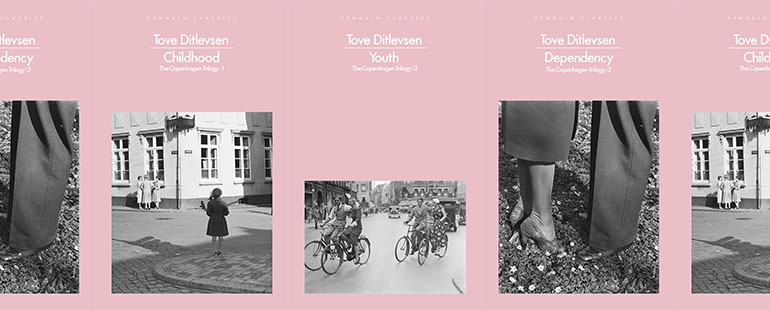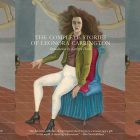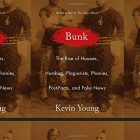Becoming One’s Mother: Tove Ditlevsen’s Copenhagen Trilogy

Tove Ditlevsen, born in 1917, has become a canonical figure in Denmark. After eleven books of poetry, seven novels, and eleven collections of short stories, as well as scores of essays, memoirs, and children’s books—much of it genre-bending work—she has achieved recognition at last, even if only posthumously. Since 2014, her work has been taught as part of the mandatory curriculum in Danish primary schools; biographies (like Karen Syberg’s Tove Ditlevsen from 2008) and plays based on her life (like the theater collective Sort Samvittighed’s 2015 Tove! Tove! Tove! and Jakob Weis’ 2016 Tove’s rum [Tove’s Room]) continue to popularize her oeuvre; and academics go on churning out dissertations and articles about her contributions to literature. In part the result of the renewed interest in her work in Denmark, Ditlevsen also has made a comeback in English. Though the first two volumes of her memoir, known as the Copenhagen Trilogy, have been available in English since the 1980s—via Tiina Nunnally’s translation for Seal Press—this project has gained recognition in the English-speaking world only recently. Last year, to much acclaim, Penguin Classics reissued the first two books in the trilogy along with Michael Favala Goldman’s translation of the third volume.
Originally published in 1967, the complete memoir—Childhood [Barndom], Youth [Ungdom], and Dependency [Gift—a Danish word that translates both as the adjective “married” and as the noun “poison”]—has been praised by Penguin as the work of “one of Denmark’s most important twentieth-century writers.” Though this statement is undoubtedly true, it is like praising A Room of One’s Own for having been written by Virginia Woolf. What makes this astonishing memoir a masterpiece is not the fact that it was written by Ditlevsen but that, much like Woolf’s long essay, it poses in vivid, urgent, and eloquent terms “an opinion upon one minor point—a woman must have money and a room of her own if she is to write fiction.” Like Woolf, Ditlevsen does “what I can to show you how I arrived at this opinion about the room and the money.” Her answer is her own biography. The memoir chronicles her life from the time of her birth to her early thirties, and from the room she shared with her parents to her own writer’s study. It is the life of a young woman with only a primary school education who wants to write so as to escape her mother’s fate, or to escape her mother’s fate so as to write. Devastatingly, however, the memoir suggests that acquiring a room of one’s own and becoming a successful writer does not preclude sharing the fate of one’s mother.
The Copenhagen Trilogy opens with an account of Ditlevsen’s Childhood in 1920s Vesterbro, a poverty-stricken, working-class neighborhood. In this world on the cusp of the first modern, global conflict, facts are “stiff and immovable, like the lampposts in the street.” Working-class children do not attend school beyond the primary level. Bedrooms are always cold. Families like the Ditlevsens are socialist. At fourteen, after Confirmation into the Catholic Church, children suddenly become adults and are expected to provide for themselves. Skilled work is the utmost to which one can aspire in life. Because needs are so pressing and income so limited, money must be considered always. Women do not write poetry.
Since the memoir is a portrait of the artist as a young woman, however, we know that the narrator, Tove, does write. She begins composing poems in her head as a young girl “when my soul was moved in this way.” One of her earliest memories, with which the volume Childhood opens, is such a scene. Echoing the opening of James Joyce’s Portrait of the Artist as a Young Man—in which the protagonist’s mother plays the piano only to then force the very young Stephen to “apologise” for wanting to marry Eileen, a Protestant neighbor—Ditlevsen similarly opens her memoir with an account of Tove’s mother—“beautiful, untouchable, lonely”—singing to her. Like Stephen’s mother, Tove’s mother becomes irritated. Tove explains that she is the cause of this irritation: “if I was absolutely still and didn’t say a word, the remote calm in her inscrutable heart would last until the morning had grown old.” More often than not, however, young Tove fails to behave as though she does not exist. Then, startled from her reverie, her mother lashes out, “slapping my face or pushing me against the stove.” At times like this, the facts of life in 1920s Copenhagen—like the fact that girls do not write poetry—are superseded by need: “‘I carried the cups out to the kitchen,” Ditlevsen remembers, “and inside of me long, mysterious words began to crawl across my soul like a protective membrane.” Although one might expect her mother to recognize this as a defense mechanism and relent, she does not: “my mother knew it, too, and her eyes would fill with cold hostility.”
What Tove aspires to, even if only instinctually, is far beyond the scope of her mother’s experience and knowledge. Her mother’s aggression is not only the result of being reminded that certain facts of life are unalterable (such as having a daughter at a young age), but also, more importantly, the result of feeling that Tove can escape indisputable facts by turning to poetry. “When these light waves of words streamed through me, I knew that my mother couldn’t do anything else to me because she had stopped being important to me,” the narrator explains. Her mother cannot do the same, does not understand this creative impulse, and resents moments that make her feel “unimportant.” Tove disappearing into her mind makes her and her life feel insignificant, just as the principal of Tove’s school does, when she rebukes Tove’s mother, thinking that she has taught Tove how to read: “My mother moves a little bit away from me and says faintly: ‘She learned it by herself, it’s not our fault.’ I look up at her and understand many things at once. She is smaller than other adult women, younger than other mothers, and there’s a world outside my street that she fears. And whenever we both fear it together, she will stab me in the back.” Just as Tove’s mother responds with aggression to Tove’s attempts to escape her by withdrawing into a mental space where she cannot follow, here, she likewise behaves in a passive aggressive manner and physically moves away from Tove. This physical separation reflects a wrenching emotional separation. Tove’s mother feels that her daughter betrays her by behaving in a way that others can use to belittle her. At the same time, Tove realizes that her mother will always demur to those she perceives to be her social betters, even if she might find their judgments suspect. So Tove pulls away, too, and identifies with those social betters. Like the principal, she judges her mother: “‘Her hands,’ the narrator remembers with distaste, ‘smell[ed] of dish soap.”
In the volumes that follow, Tove will go on attempting to become one of her mother’s social betters, even as her mother will go on attempting to help her secure a safe life that resembles her own. What makes Ditlevsen’s memoir so powerful is that it does not avoid difficult questions about the relationship between women’s bodies, cultural capital, and social class. Nor does Ditlevsen suppress Tove’s social and material aspirations. Tove wants to be a poet not only because she wants to see her name in print, but also because she realizes that to be a poet is to have a life different from her mother’s—to escape her mother literally rather than figuratively. When “Brochmann,” the editor of the children’s section of left-wing newspaper Social-Demokraten, the first publisher to whom she shows her poems, rejects her work because it is too mature for a fourteen-year old, she despairs not only because “I’ll never be famous, my poems are worthless,” but also because her mother’s dream is for her to “marry a stable skilled worker who doesn’t drink” or, failing that, to “get a steady job with a pension,” neither of which option appeals to her.
Tove’s attachment to Brochmann in Youth prefigures her romantic attachment to the man who finally will publish her first poems, Viktor Møller, the editor of the Copenhagen literary magazine Wild Wheat. “He is the person I’ve waited for all my life, Tove thinks.” Ironically, despite believing that she is rejecting her mother’s blueprint for life, the man who can help her secure publication becomes her own version of her mother’s much-praised skilled worker. In response to her mother’s observation that “he probably wants to marry you,” she thinks: “If he’s single, I have nothing against marrying him. Entirely sight unseen.” Despite the fact that she is eighteen and Møller is fifty-three, she decides that “I’m going to meet him. I’m going to talk to him. He undoubtedly wants to do something for me. . .People always wanted to use each other for something, and there was nothing wrong with that. It’s quite clear what I want to use the editor for, but what does he want to use me for?” As the reader has been led to suspect all along, the tradeoff will be one between the titular youth and capital—both economic and cultural.
Møller has a wall of books, “green-shaded lamps,” a functional shower (“if we really get married, I’ll take a shower every single day”), and knows how to order a taxi. He is friends with many Danish celebrities, and he hosts lavish parties. To Tove, he represents everything she has never had, that her mother has never had. “‘I get furious at my whole upbringing,’ she grumbles, ‘at my ignorance, my language, my complete lack of sophistication and culture words I hardly understand.” She feels “as if I’m very tired after a long, long trip, and now have finally found home.” Despite believing that Møller’s house is the cultured, bourgeois home in which she has always belonged, however, Tove behaves in complete accordance to her mother’s expectations. She treats Møller as a social better, and she “hide[s] everything that could make him have misgivings about marrying me.” Eventually, she gets what she wants: security, comfort, capital, and “My book!”
Throughout Tove’s life, this pattern will repeat over and over again. She will divorce Møller only to marry the son of a dean of the Høng Business School, only to then divorce him in favor of a physician, whom she will also eventually divorce and replace. It is a dependency, as the English edition tile of the third volume of Ditlevsen’s memoir hints. Tove wants to write, but she also cannot escape the desire to be “normal and regular.” She thinks—as her mother does—that men and money are necessary to accomplish both goals. In the case of her third husband, the need is even more basic. Yes, he provides the “civilized frame around our life,” the custom-built suburban brick house, the maid, the middle-class comfort. But even more to the point, as a physician, he is able to prescribe her opioids like Demerol. Such drugs give her “bliss” and “relief.” At least in the beginning, they allow her to escape the pressures of attempting to reconcile her writer’s vocation with the demands of marriage and motherhood, “lifting me up to the only level where I wanted to exist.”
In showing that Tove’s life has been upended by such attempts at normalization, the beauty of Ditlevsen’s memoir lies in the fact that no narrative can encompass a life fully, or explain it away. One of the points Ditlevsen makes is that, inside the Tove of Youth and Dependency, there is still the Tove of Childhood. This Tove, like her mother, is “beautiful, untouchable, lonely,” the poet who understands that life is the sum of everyday occurrences, of trivial, inconsequential, ephemeral, and ordinary experiences and observations. Life is the feeling that “it’s always winter, and out in the world it’s ice cold like in the bedroom and the kitchen.” Life is Granny who “makes the sign of the cross before she cuts the bread.” Life is “my mother stand[ing] there in all of the black tulle, which is covered over with hundreds of shiny sequins.” It is as if, all along, we are faced with someone who, despite everything that has happened to her, is still speaking from “the remote calm in her inscrutable heart,” like her mother in the opening pages of the memoir. In a room of her own, Ditlevsen makes the world shimmer. It is the loss of this shimmer, of the nights whose “air is like damp silk,” of those whose “wet, silvery stillness fills the room,” and of those “so quiet we could hear the thumping from the ships’ motors far out on the water” (like the night she meets Evelyn Waugh), that hint at the devastation caused by the attempts to reconcile writing, respectability, and married life. Indeed, it is only when the narrative-resistant haphazard poetry of the everyday disappears, when the ability that early on gave her respite from her mother fades, and the memoir’s lyrical strain gives way to plodding prose, that we realize that something is very wrong.
Ironically, in order to save herself, Tove must turn away from herself, as her mother once turned away from her. In the closing pages of Dependency, as she is “walking down the main street of Vordingborg,” she looks into a pharmacy window. “Horrified, I realized while I stood there the longing [for methadone] was inside me like rot in a tree, or like an embryo growing all on its own, even though you want nothing to do with it. I pulled myself away reluctantly and kept walking. . .Then I thought. . .about my three children, who didn’t know their mother anymore, just as I didn’t think I knew them.” In the shocking simile, Tove’s addiction becomes the child she must reject so that she can attempt a relationship with the children she has never properly known. It is almost as if we are back where we began, poignantly experiencing the scene with Tove’s principal, but, this time, from her mother’s perspective. There is Tove, physically pulling away: “She is smaller than other adult women, younger than other mothers, and there’s a world outside my street that she fears. And whenever we both fear it together, she will stab me in the back.”
Like Virginia Woolf’s A Room of One’s Own, this melancholic, sublime memoir asks us to consider the price that a woman must pay to have a room to herself, and what Shakespeare’s “extraordinarily gifted sister” might have done if she was just as talented as her brother. “Perhaps she scribbled some pages. . .on the sly but was careful to hide them or set fire to them.” Perhaps “she cried out that marriage was hateful to her” and rejected her family’s attempts to wed her to a skilled worker, “the son of a neighbouring wool-stapler.” Perhaps she “would have been so thwarted and hindered by other people, so tortured and pulled asunder by her own contrary instincts, that she must have lost her health and sanity to a certainty.” Perhaps, she “killed herself one winter’s night and lies buried at some cross-roads where the omnibuses now stop outside the Elephant and Castle.” These are Woolf’s musings, but they are also Ditlevsen’s, who, in 1976, eventually would die by suicide like “Shakespeare’s sister.”
This piece was originally published on January 30, 2020.



